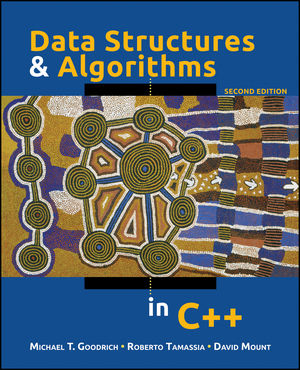Test bank for Data Structures and Algorithms in C++ 2nd Edition by Goodrich
$55.00 Original price was: $55.00.$29.99Current price is: $29.99.
Test bank for Data Structures and Algorithms in C++ 2nd Edition by Goodrich
Instant download Test bank for Data Structures and Algorithms in C++ 2nd Edition by Goodrich pdf docx epub after payment.
Product details:
- ISBN-10 : 0470383275
- ISBN-13 : 978-0470383278
- Author: Goodrich
This second edition of Data Structures and Algorithms in C++ is designed to provide an introduction to data structures and algorithms, including their design, analysis, and implementation. The authors offer an introduction to object-oriented design with C++ and design patterns, including the use of class inheritance and generic programming through class and function templates, and retain a consistent object-oriented viewpoint throughout the book.
This is a “sister” book to Goodrich & Tamassia’s Data Structures and Algorithms in Java, but uses C++ as the basis language instead of Java. This C++ version retains the same pedagogical approach and general structure as the Java version so schools that teach data structures in both C++ and Java can share the same core syllabus.
Table Of Contents:
1 A C++ Primer 1
1.1 Basic C++ Programming Elements 2
1.1.1 A Simple C++ Program 2
1.1.2 Fundamental Types 4
1.1.3 Pointers, Arrays, and Structures 7
1.1.4 Named Constants, Scope, and Namespaces 13
1.2 Expressions 16
1.2.1 Changing Types through Casting 20
1.3 Control Flow 23
1.4 Functions 26
1.4.1 Argument Passing 28
1.4.2 Overloading and Inlining 30
1.5 Classes 32
1.5.1 Class Structure 33
1.5.2 Constructors and Destructors 37
1.5.3 Classes and Memory Allocation 40
1.5.4 Class Friends and Class Members 43
1.5.5 The Standard Template Library 45
1.6 C++ Program and File Organization 47
1.6.1 An Example Program 48
1.7 Writing a C++ Program53
1.7.1 Design 54
1.7.2 Pseudo-Code 54
1.7.3 Coding 55
1.7.4 Testing and Debugging 57
1.8 Exercises 60
2 Object-Oriented Design 65
2.1 Goals, Principles, and Patterns 66
2.1.1 Object-Oriented Design Goals 66
2.1.2 Object-Oriented Design Principles 67
2.1.3 Design Patterns 70
2.2 Inheritance and Polymorphism 71
2.2.1 Inheritance in C++ 71
2.2.2 Polymorphism 78
2.2.3 Examples of Inheritance in C++ 79
2.2.4 Multiple Inheritance and Class Casting 84
2.2.5 Interfaces and Abstract Classes 87
2.3 Templates 90
2.3.1 Function Templates 90
2.3.2 Class Templates 91
2.4 Exceptions 93
2.4.1 Exception Objects 93
2.4.2 Throwing and Catching Exceptions 94
2.4.3 Exception Specification 96
2.5 Exercises 98
3 Arrays, Linked Lists, and Recursion 103
3.1 Using Arrays 104
3.1.1 Storing Game Entries in an Array 104
3.1.2 Sorting an Array 109
3.1.3 Two-Dimensional Arrays and Positional Games 111
3.2 Singly Linked Lists 117
3.2.1 Implementing a Singly Linked List 117
3.2.2 Insertion to the Front of a Singly Linked List 119
3.2.3 Removal from the Front of a Singly Linked List 119
3.2.4 Implementing a Generic Singly Linked List 121
3.3 Doubly Linked Lists 123
3.3.1 Insertion into a Doubly Linked List 123
3.3.2 Removal from a Doubly Linked List 124
3.3.3 A C++ Implementation 125
3.4 Circularly Linked Lists and List Reversal 129
3.4.1 Circularly Linked Lists 129
3.4.2 Reversing a Linked List 133
3.5 Recursion 134
3.5.1 Linear Recursion 140
3.5.2 Binary Recursion 144
3.5.3 Multiple Recursion 147
3.6 Exercises 149
4 Analysis Tools 153
4.1 The Seven Functions Used in This Book 154
4.1.1 The Constant Function 154
4.1.2 The Logarithm Function 154
4.1.3 The Linear Function 156
4.1.4 The N-Log-N Function 156
4.1.5 The Quadratic Function 156
4.1.6 The Cubic Function and Other Polynomials 158
4.1.7 The Exponential Function 159
4.1.8 Comparing Growth Rates 161
4.2 Analysis of Algorithms 162
4.2.1 Experimental Studies 163
4.2.2 Primitive Operations 164
4.2.3 Asymptotic Notation 166
4.2.4 Asymptotic Analysis 170
4.2.5 Using the Big-Oh Notation 172
4.2.6 A Recursive Algorithm for Computing Powers 176
4.2.7 Some More Examples of Algorithm Analysis 177
4.3 Simple Justification Techniques 181
4.3.1 By Example 181
4.3.2 The “Contra” Attack 181
4.3.3 Induction and Loop Invariants 182
4.4 Exercises 185
5 Stacks, Queues, and Deques 193
5.1 Stacks 194
5.1.1 The Stack Abstract Data Type 195
5.1.2 The STL Stack 196
5.1.3 A C++ Stack Interface 196
5.1.4 A Simple Array-Based Stack Implementation 198
5.1.5 Implementing a Stack with a Generic Linked List 202
5.1.6 Reversing a Vector Using a Stack 203
5.1.7 Matching Parentheses and HTML Tags 204
5.2 Queues 208
5.2.1 The Queue Abstract Data Type 208
5.2.2 The STL Queue 209
5.2.3 A C++ Queue Interface 210
5.2.4 A Simple Array-Based Implementation 211
5.2.5 Implementing a Queue with a Circularly Linked List 213
5.3 Double-Ended Queues 217
5.3.1 The Deque Abstract Data Type 217
5.3.2 The STL Deque 218
5.3.3 Implementing a Deque with a Doubly Linked List 218
5.3.4 Adapters and the Adapter Design Pattern 220
5.4 Exercises 223
6 List and Iterator ADTs 227
6.1 Vectors 228
6.1.1 The Vector Abstract Data Type 228
6.1.2 A Simple Array-Based Implementation 229
6.1.3 An Extendable Array Implementation 231
6.1.4 STL Vectors 236
6.2 Lists 238
6.2.1 Node-Based Operations and Iterators 238
6.2.2 The List Abstract Data Type 240
6.2.3 Doubly Linked List Implementation 242
6.2.4 STL Lists 247
6.2.5 STL Containers and Iterators 248
6.3 Sequences 255
6.3.1 The Sequence Abstract Data Type 255
6.3.2 Implementing a Sequence with a Doubly Linked List .255
6.3.3 Implementing a Sequence with an Array 257
6.4 Case Study: Bubble-Sort on a Sequence 259
6.4.1 The Bubble-Sort Algorithm 259
6.4.2 A Sequence-Based Analysis of Bubble-Sort 260
6.5 Exercises 262
7 Trees 267
7.1 General Trees 268
7.1.1 Tree Definitions and Properties 269
7.1.2 Tree Functions 272
7.1.3 A C++ Tree Interface 273
7.1.4 A Linked Structure for General Trees 274
7.2 Tree Traversal Algorithms 275
7.2.1 Depth and Height 275
7.2.2 Preorder Traversal 278
7.2.3 Postorder Traversal 281
7.3 Binary Trees 284
7.3.1 The Binary Tree ADT 285
7.3.2 A C++ Binary Tree Interface 286
7.3.3 Properties of Binary Trees 287
7.3.4 A Linked Structure for Binary Trees 289
7.3.5 A Vector-Based Structure for Binary Trees 295
7.3.6 Traversals of a Binary Tree 297
7.3.7 The Template Function Pattern 303
7.3.8 Representing General Trees with Binary Trees 309
7.4 Exercises 310
8 Heaps and Priority Queues 321
8.1 The Priority Queue Abstract Data Type 322
8.1.1 Keys, Priorities, and Total Order Relations 322
8.1.2 Comparators 324
8.1.3 The Priority Queue ADT 327
8.1.4 A C++ Priority Queue Interface 328
8.1.5 Sorting with a Priority Queue 329
8.1.6 The STL priority queue Class 330
8.2 Implementing a Priority Queue with a List 331
8.2.1 A C++ Priority Queue Implementation using a List 333
8.2.2 Selection-Sort and Insertion-Sort 335
8.3 Heaps 337
8.3.1 The Heap Data Structure 337
8.3.2 Complete Binary Trees and Their Representation 340
8.3.3 Implementing a Priority Queue with a Heap 344
8.3.4 C++ Implementation 349
8.3.5 Heap-Sort 351
8.3.6 Bottom-Up Heap Construction ⋆ 353
8.4 Adaptable Priority Queues 357
8.4.1 A List-Based Implementation 358
8.4.2 Location-Aware Entries 360
8.5 Exercises 361
9 Hash Tables, Maps, and Skip Lists 367
9.1 Maps 368
9.1.1 The Map ADT 369
9.1.2 A C++ Map Interface 371
9.1.3 The STL map Class 372
9.1.4 A Simple List-Based Map Implementation 374
9.2 Hash Tables 375
9.2.1 Bucket Arrays 375
9.2.2 Hash Functions 376
9.2.3 Hash Codes 376
9.2.4 Compression Functions 380
9.2.5 Collision-Handling Schemes 382
9.2.6 Load Factors and Rehashing 386
9.2.7 A C++ Hash Table Implementation 387
9.3 Ordered Maps 394
9.3.1 Ordered Search Tables and Binary Search 395
9.3.2 Two Applications of Ordered Maps 399
9.4 Skip Lists 402
9.4.1 Search and Update Operations in a Skip List 404
9.4.2 A Probabilistic Analysis of Skip Lists ⋆ 408
9.5 Dictionaries 411
9.5.1 The Dictionary ADT 411
9.5.2 A C++ Dictionary Implementation 413
9.5.3 Implementations with Location-Aware Entries 415
9.6 Exercises 417
People also search:
data structures and algorithms in c++ 2nd edition solutions pdf
data structures and algorithms in c++ 2nd edition
c++ algorithms and data structures pdf
data structures and algorithms in c++ second edition
Related products
Test Bank
Test Bank for Clinical Immunology and Serology A Laboratory Perspective, 3rd Edition: Stevens












